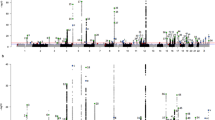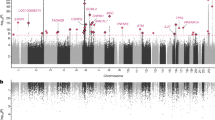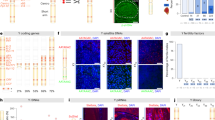Abstract
Studies have suggested mosaic loss of chromosome Y (mLOY) in blood-derived DNA is common in older men. Cohort studies investigating mLOY and mortality have reported contradictory results. Previous work found that a 1.6 Mb deletion of the AZFc region on the Y chromosome (the ‘gr/gr’ deletion) is associated with both male infertility and increased risk of testicular germ cell tumors (TGCT). We investigated whether mosaic loss across the entire Y chromosome was associated with TGCT. We obtained blood- and buccal-derived DNA from two case–control studies: the NCI Familial Testicular Cancer Study (cases=172; controls=163) and the NCI US Servicemen’s Testicular Tumor Environmental and Endocrine Determinants Study (cases=506; controls=611). We used 15 quantitative polymerase chain reactions spanning the Y chromosome to assess mLOY. Multivariate logistic regression models adjusted for study batch effects detected no significant overall relationship between mean chromosome Y target-to-reference (T/R) ratio and TGCT (odds ratio=0.34, 95% confidence interval=0.10–1.17, P=0.09). When restricted to familial TGCT cases, a significantly lower T/R ratio was observed in cases compared with controls (0.993 vs 1.014, P-value=0.01). Our study suggests that mLOY, as measured by 15 probes spanning the Y chromosome, could be associated with familial TGCT, but larger studies are required to confirm this observation.
Similar content being viewed by others
Log in or create a free account to read this content
Gain free access to this article, as well as selected content from this journal and more on nature.com
or
References
Siegel, R. L., Miller, K. D. & Jemal, A. Cancer statistics, 2016. CA Cancer J. Clin. 66, 7–30 (2016).
Ghazarian, A. A., Trabert, B., Graubard, B. I., Schwartz, S. M., Altekruse, S. F. & McGlynn, K. A. Incidence of testicular germ cell tumors among US men by census region. Cancer 121, 4181–4189 (2015).
Rajpert-De Meyts, E., McGlynn, K. A., Okamoto, K., Jewett, M. A. & Bokemeyer, C. Testicular germ cell tumours. Lancet 387, 1762–1774 (2016).
Chung, C. C., Kanetsky, P. A., Wang, Z., Hildebrandt, M. A., Koster, R., Skotheim, R. I. et al. Meta-analysis identifies four new loci associated with testicular germ cell tumor. Nat. Genet. 45, 680–685 (2013).
Litchfield, K., Holroyd, A., Lloyd, A., Broderick, P., Nsengimana, J., Eeles, R. et al. Identification of four new susceptibility loci for testicular germ cell tumour. Nat. Commun. 6, 8690 (2015).
Nathanson, K. L., Kanetsky, P. A., Hawes, R., Vaughn, D. J., Letrero, R., Tucker, K. et al. The Y deletion gr/gr and susceptibility to testicular germ cell tumor. Am. J. Hum. Genet. 77, 1034–1043 (2005).
Youssoufian, H. & Pyeritz, R. E. Mechanisms and consequences of somatic mosaicism in humans. Nat. Rev. Genet. 3, 748–758 (2002).
Machiela, M. J. & Chanock, S. J. Detectable clonal mosaicism in the human genome. Semin. Hematol. 50, 348–359 (2013).
Jacobs, K. B., Yeager, M., Zhou, W., Wacholder, S., Wang, Z., Rodriguez-Santiago, B. et al. Detectable clonal mosaicism and its relationship to aging and cancer. Nat. Genet. 44, 651–658 (2012).
Laurie, C. C., Laurie, C. A., Rice, K., Doheny, K. F., Zelnick, L. R., McHugh, C. P. et al. Detectable clonal mosaicism from birth to old age and its relationship to cancer. Nat. Genet. 44, 642–650 (2012).
Machiela, M. J., Zhou, W., Sampson, J. N., Dean, M. C., Jacobs, K. B., Black, A. et al. Characterization of large structural genetic mosaicism in human autosomes. Am. J. Hum. Genet. 96, 487–497 (2015).
Forsberg, L. A., Rasi, C., Malmqvist, N., Davies, H., Pasupulati, S., Pakalapati, G. et al. Mosaic loss of chromosome Y in peripheral blood is associated with shorter survival and higher risk of cancer. Nat. Genet. 46, 624–628 (2014).
Dumanski, J. P., Rasi, C., Lonn, M., Davies, H., Ingelsson, M., Giedraitis, V. et al. Mutagenesis. Smoking is associated with mosaic loss of chromosome Y. Science 347, 81–83 (2015).
Zhou, W., Machiela, M. J., Freedman, N. D., Rothman, N., Malats, N., Dagnall, C. et al. Mosaic loss of chromosome Y is associated with common variation near TCL1A. Nat. Genet. 48, 563–568 (2016).
Korde, L. A., Premkumar, A., Mueller, C., Rosenberg, P., Soho, C., Bratslavsky, G. et al. Increased prevalence of testicular microlithiasis in men with familial testicular cancer and their relatives. Br J Cancer 99, 1748–1753 (2008).
Greene, M. H., Mai, P. L., Loud, J. T., Pathak, A., Peters, J. A., Mirabello, L. et al. Familial testicular germ cell tumors (FTGCT)—overview of a multidisciplinary etiologic study. Andrology 3, 47–58 (2015).
McGlynn, K. A., Sakoda, L. C., Rubertone, M. V., Sesterhenn, I. A., Lyu, C., Graubard, B. I. et al. Body size, dairy consumption, puberty, and risk of testicular germ cell tumors. Am. J. Epidemiol. 165, 355–363 (2007).
Cook, M. B., Chia, V. M., Berndt, S. I., Graubard, B. I., Chanock, S. J., Rubertone, M. V. et al. Genetic contributions to the association between adult height and testicular germ cell tumors. Int. J. Epidemiol. 40, 731–739 (2011).
Baer, M., Nilsen, T. W., Costigan, C. & Altman, S. Structure and transcription of a human gene for H1 RNA, the RNA component of human RNase P. Nucleic Acids Res. 18, 97–103 (1990).
Lindor, N. M. M. M., Lindor, C. J. & Greene, M. H. Concise handbook of familial cancer susceptibility syndromes—second edition. J. Natl. Cancer Inst. Monogr. 1–93 (2008).
Mai, P. L., Friedlander, M., Tucker, K., Phillips, K. A., Hogg, D., Jewett, M. A. et al. The International Testicular Cancer Linkage Consortium: a clinicopathologic descriptive analysis of 461 familial malignant testicular germ cell tumor kindred. Urol. Oncol. 28, 492–499 (2010).
Acknowledgements
This project was funded by the Intramural Research Program of the United States National Cancer Institute, Division of Cancer Epidemiology and Genetics. The content of this publication does not necessarily reflect the views or policies of the Department of Health and Human Services, nor does mention of trade names, commercial products or organizations imply endorsement by the US Government.
Author information
Authors and Affiliations
Corresponding author
Ethics declarations
Competing interests
The authors declare no conflict of interest.
Additional information
Supplementary Information accompanies the paper on Journal of Human Genetics website
Supplementary information
Rights and permissions
About this article
Cite this article
Machiela, M., Dagnall, C., Pathak, A. et al. Mosaic chromosome Y loss and testicular germ cell tumor risk. J Hum Genet 62, 637–640 (2017). https://doi.org/10.1038/jhg.2017.20
Received:
Revised:
Accepted:
Published:
Issue date:
DOI: https://doi.org/10.1038/jhg.2017.20
This article is cited by
-
Estimation of mosaic loss of Y chromosome cell fraction with genotyping arrays lacking coverage in the pseudoautosomal region
BMC Bioinformatics (2025)
-
Y chromosome is moving out of sex determination shadow
Cell & Bioscience (2022)
-
A polygenic risk score predicts mosaic loss of chromosome Y in circulating blood cells
Cell & Bioscience (2021)
-
Incident disease associations with mosaic chromosomal alterations on autosomes, X and Y chromosomes: insights from a phenome-wide association study in the UK Biobank
Cell & Bioscience (2021)
-
Germline risk of clonal haematopoiesis
Nature Reviews Genetics (2021)



